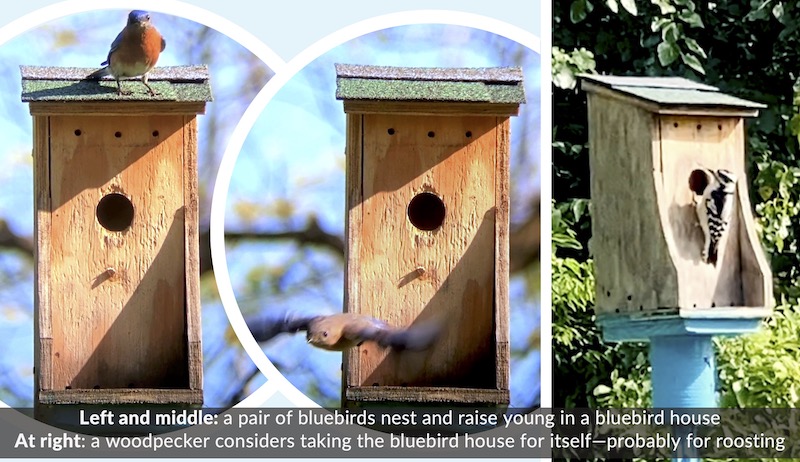
Downy woodpeckers may be small, but they have great big personalities. I usually only see these black-and-white beauties when they’re snacking on the suet cakes and black oil sunflower seeds I offer this time of year.
But I recently noticed a female downy woodpecker had taken a strong interest in my bluebird house. Despite the bluebird pair which has raised multiple broods there over the last few years, the downy woodpecker has been alighting on the front of the nest box and pecking madly around the entrance hole.
I’m used to monitoring the bluebird box for wrens hoping to take over, but this was a first. After a little research, I determined that the woodpecker is probably seeking a warm place to roost. In the hopes that I could lure it away from the bluebirds’ digs, I decided to add some extra woodpecker habitat. Although both downy and hairy woodpeckers generally nest in dead tree cavities, sometimes they will accept manmade nest boxes.
Rather than build something fancy from new—and expensive!—wood, I used a large, partially hollow tree limb as the basis for my downy woodpecker nest box. If you have access to an old log or suitable tree limb, you just might have a good start on your own downy woodpecker nest box.

Specifications
Ideally, the floor size for your downy woodpecker nest cavity should measure about 4 inches by 4 inches. The entrance hole to the birdhouse should be an inch-and-a-half in diameter, and the hole itself should be located roughly 9 inches up from the bottom of the birdhouse.
The nest cavity interior should measure about 1 foot tall.
I found a partially hollow limb that easily could easily meet each of these requirements. It was about 7 inches in diameter and a few feet long. Although the wood along one end and around the sides of the limb was still intact, the interior at the other end of the limb had become spongy.
If this limb were still up in its original tree, it would be prime real estate for a downy woodpecker. But since it had already fallen to the ground, I’d need to make a few adjustments in order to make it a suitable potential nest site once again.
Since the interior section of the tree limb had already begun to break down, it was soft enough for me to carve out with a hammer and chisel.
Read more: Build a handmade bluebird house with these plans.
Step by Step
Now, you don’t necessarily have to find a cavity-riddled log in order to make your own woodpecker nest box, but having the start of a cavity does make the work much easier. To start, cut the log or limb section so that it’s about a foot-and-a-half tall.
If your log already has the start of a cavity, use a hammer and chisel to enlarge it as needed. Remember, the goal is to create an interior nesting section that is 4 by 4 inches across and 1 foot high.
(If the log you select lacks a cavity, measure and mark a 4-by-4-inch area at the center of one end. Next, drill a series of large holes inside the area you marked, then carefully use a hammer and chisel to further enlarge the nesting cavity.)
When you’ve finished excavating, you should have a log with an opening at one end. Cover this open end with a piece of scrap wood and secure with nails or screws. (If this will be the roof of your woodpecker house, you might also want to add some spare roofing shingles or additional overhang to help keep the nest dry.)
Measure 9 inches up from the bottom of the nesting cavity and use a 1.5-inch wood boring drill bit to add the entrance hole.
Finishing Touches
I mounted my woodpecker house several feet up atop a sturdy base attached to a freestanding post. (If you can, angle your birdhouse forward about 15 degrees and then fasten it securely in place. Angling the log this way will help juvenile woodpeckers have an easier time launching themselves out of the nest box when the time is right.)
Finally, because excavating potential nesting sites is an important part of their courtship and breeding behavior, I stuffed the birdhouse’s interior with clean, dry pine shavings. And, to further lure the downy woodpeckers away from my bluebird house, I also attached a bit of suet cake along the underside of the new birdhouse’s mounting shelf.
So far, it seems to have done the trick.




